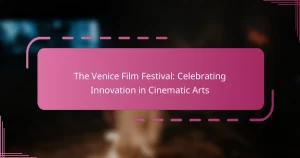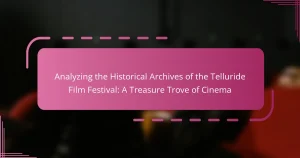The Tribeca Film Festival is an annual event in New York City, founded in 2002 by Robert De Niro, Jane Rosenthal, and Craig Hatkoff, aimed at promoting independent filmmaking and showcasing diverse voices in cinema. The festival emphasizes representation by highlighting underrepresented communities and stories through a wide array of films from various genres and cultures. It also fosters dialogue and understanding among audiences, while implementing initiatives to support inclusion within the film industry. With over 1,500 films showcased, the festival has played a significant role in revitalizing lower Manhattan and influencing other festivals to prioritize diversity and inclusion, ultimately reshaping the landscape of independent filmmaking and cultural discourse.
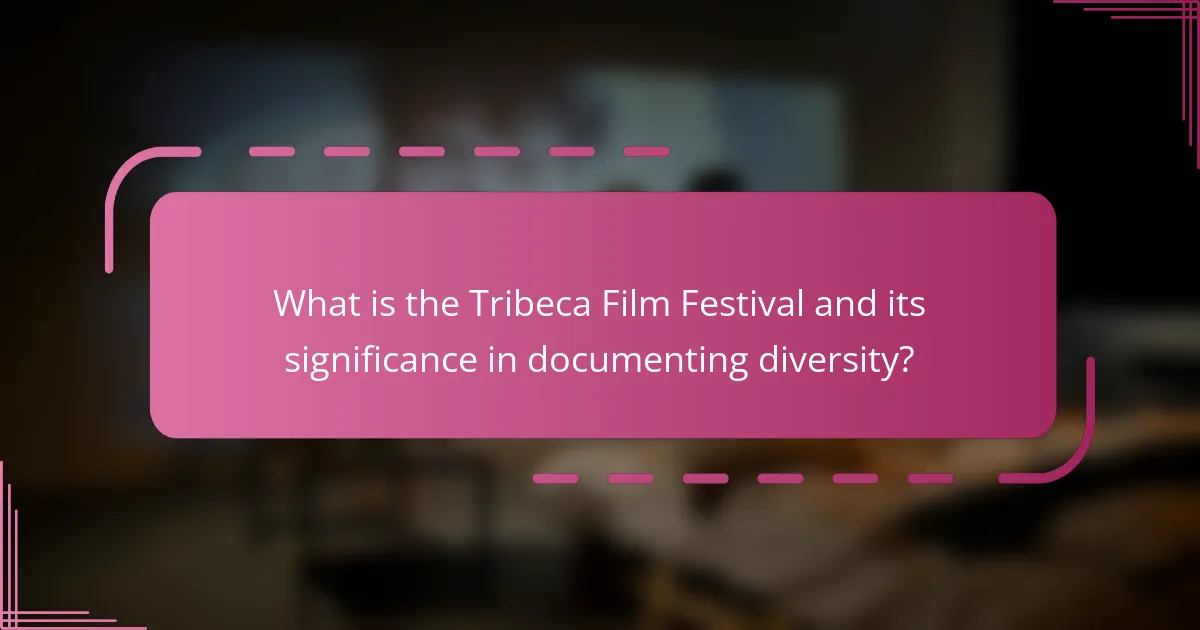
What is the Tribeca Film Festival and its significance in documenting diversity?
The Tribeca Film Festival is an annual film festival held in New York City. It was founded in 2002 by Robert De Niro, Jane Rosenthal, and Craig Hatkoff. The festival aims to promote independent filmmaking and showcase diverse voices in cinema. Its significance lies in its commitment to highlighting underrepresented communities and stories. The festival features films from a variety of genres, cultures, and perspectives. It provides a platform for filmmakers from marginalized backgrounds. This focus on diversity helps foster dialogue and understanding among different audiences. The festival has also implemented initiatives to support inclusion within the film industry.
How did the Tribeca Film Festival originate and evolve over time?
The Tribeca Film Festival originated in 2002. It was founded by Robert De Niro, Jane Rosenthal, and Craig Hatkoff. The festival aimed to revitalize Lower Manhattan after the September 11 attacks. It focused on showcasing independent films and fostering community engagement. Over time, the festival expanded its programming to include discussions, panels, and live performances. It has become a platform for diverse voices in cinema. The festival also emphasizes social issues and cultural representation. Today, it attracts filmmakers and audiences from around the world.
What were the key historical events that led to the establishment of the festival?
The Tribeca Film Festival was established in response to the September 11 attacks in 2001. The attacks significantly impacted New York City, leading to economic and cultural challenges. In 2002, Robert De Niro and Jane Rosenthal co-founded the festival to revitalize the Tribeca neighborhood. The festival aimed to promote the arts and encourage community engagement. Its first edition took place in 2002, showcasing independent films. The event attracted filmmakers and audiences, fostering a sense of unity. Over the years, it has grown into a major cultural event, celebrating diverse voices in cinema.
How has the festival’s mission changed since its inception?
The Tribeca Film Festival’s mission has evolved to prioritize diversity and inclusion. Initially, the festival aimed to revitalize Lower Manhattan post-9/11. Over time, it shifted focus to amplify underrepresented voices in film. This change reflects a broader commitment to social issues and representation. In recent years, the festival has emphasized showcasing diverse filmmakers and stories. This includes initiatives to support women and people of color in the industry. The festival now serves as a platform for dialogue on cultural and social themes. This mission change aligns with the evolving landscape of the film industry and audience expectations.
Why is diversity an essential theme at the Tribeca Film Festival?
Diversity is an essential theme at the Tribeca Film Festival because it promotes inclusivity in storytelling. The festival aims to showcase a wide range of voices and perspectives. This commitment enriches the cinematic experience for audiences. Historically, the festival has provided a platform for underrepresented filmmakers. It highlights stories from various cultural, racial, and social backgrounds. According to the festival’s mission, diverse narratives foster empathy and understanding. By prioritizing diversity, the Tribeca Film Festival reflects the real-world tapestry of experiences. This approach aligns with industry trends emphasizing representation in film.
What specific aspects of diversity does the festival aim to highlight?
The festival aims to highlight cultural, racial, and gender diversity. It showcases films from underrepresented communities. The Tribeca Film Festival emphasizes stories from diverse perspectives. It promotes inclusion in the film industry. The festival features filmmakers from various backgrounds. This diversity enriches the cinematic experience. The festival also addresses social issues through storytelling. It fosters dialogue about representation in media.
How does the festival promote underrepresented voices in the film industry?
The festival promotes underrepresented voices in the film industry through dedicated programming and initiatives. It features films created by diverse filmmakers, highlighting stories from various cultural backgrounds. The festival also provides mentorship opportunities for emerging talent from underrepresented communities. This support helps to elevate their work within a competitive industry landscape. Additionally, the festival hosts panels and discussions focused on diversity in filmmaking. These platforms encourage dialogue about representation and inclusion. This approach aligns with the festival’s mission to foster a more equitable film industry. By prioritizing diverse narratives, the festival amplifies voices that are often marginalized.
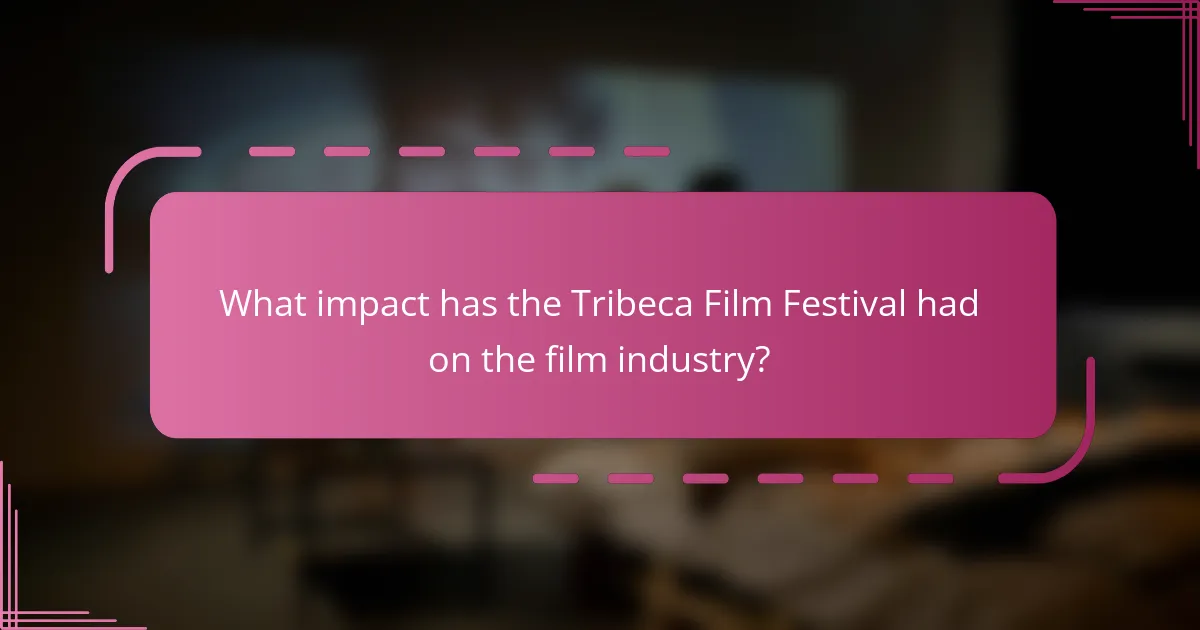
What impact has the Tribeca Film Festival had on the film industry?
The Tribeca Film Festival has significantly influenced the film industry by promoting independent cinema. It provides a platform for diverse voices and stories, enhancing representation. Established in 2002, the festival has showcased over 1,500 films from various genres. It has also introduced innovative programming, such as virtual reality and immersive storytelling. The festival fosters connections between filmmakers and industry leaders, facilitating career advancements. Additionally, it has contributed to the revitalization of lower Manhattan post-9/11, demonstrating the cultural power of film. Its commitment to social issues has inspired other festivals to prioritize diversity and inclusion. Overall, the Tribeca Film Festival has reshaped the landscape of independent filmmaking and cultural discourse.
How has the festival influenced the representation of diverse stories in cinema?
The festival has significantly influenced the representation of diverse stories in cinema. It has provided a platform for underrepresented voices. The Tribeca Film Festival showcases films from diverse cultural backgrounds. This exposure leads to increased awareness and appreciation of varied narratives. In 2021, 50% of the films featured were directed by women or people of color. Such statistics highlight the festival’s commitment to diversity. By prioritizing these stories, the festival encourages broader industry representation. This shift impacts audience perceptions and fosters inclusivity in filmmaking.
What notable films showcased at the festival have made a significant impact?
Notable films showcased at the Tribeca Film Festival include “The Last Black Man in San Francisco” and “A Beautiful Day in the Neighborhood.” “The Last Black Man in San Francisco” explores themes of gentrification and identity. It received critical acclaim for its storytelling and cinematography. “A Beautiful Day in the Neighborhood” highlights the impact of kindness and empathy in a world often lacking these values. Both films sparked important conversations about social issues. Their screenings at the festival contributed to discussions on diversity and representation in cinema.
How do filmmakers perceive the festival’s role in promoting diversity?
Filmmakers perceive the festival as a crucial platform for promoting diversity. They believe it amplifies underrepresented voices in the film industry. The festival showcases films from diverse backgrounds and perspectives. This inclusion fosters broader conversations about race, gender, and social issues. Filmmakers also highlight the festival’s commitment to supporting marginalized creators. For example, Tribeca has initiatives that specifically focus on women and people of color. These efforts contribute to a more inclusive cinematic landscape. The festival’s impact is evident in the increased visibility of diverse narratives. This perception aligns with studies showing that diverse storytelling enriches the film industry as a whole.
What partnerships and collaborations has the festival formed to enhance diversity?
The Tribeca Film Festival has formed partnerships with various organizations to enhance diversity. Collaborations include initiatives with the National Association of Latino Independent Producers. This partnership aims to support Latino filmmakers and promote diverse storytelling. The festival also works with Women in Film, focusing on increasing representation of women in cinema. Additionally, it collaborates with the Blackhouse Foundation to support Black filmmakers. These partnerships reflect the festival’s commitment to inclusivity and representation in the film industry. By fostering these collaborations, the festival actively contributes to a more diverse cinematic landscape.
How do these partnerships contribute to the festival’s mission?
Partnerships enhance the festival’s mission by providing resources and support for diverse storytelling. They facilitate collaboration with various cultural organizations and sponsors. This collaboration allows for a wider range of films that reflect diverse perspectives. Additionally, partnerships help in funding initiatives that promote underrepresented voices in cinema. Historical data shows that such collaborations have increased the number of films from diverse creators showcased at the festival. This aligns with the festival’s goal of celebrating and documenting diversity in film.
What initiatives have emerged from these collaborations?
Collaborations at the Tribeca Film Festival have led to various initiatives promoting diversity in film. One key initiative is the Tribeca Film Institute’s support for underrepresented filmmakers. This program provides funding and resources to enhance their visibility. Another initiative is the partnership with educational institutions to create mentorship programs. These programs connect emerging filmmakers with industry veterans. Additionally, collaborations have resulted in themed screenings that highlight diverse narratives. These screenings aim to engage broader audiences and foster discussions on representation. Overall, these initiatives reflect a commitment to inclusivity and the celebration of diverse voices in cinema.
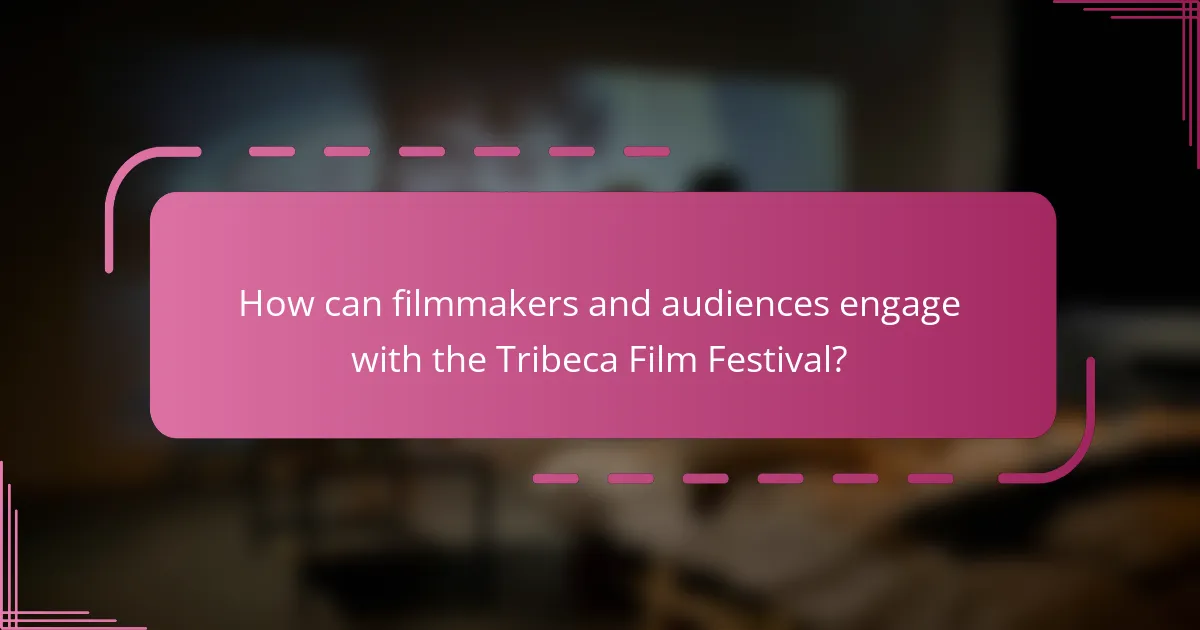
How can filmmakers and audiences engage with the Tribeca Film Festival?
Filmmakers and audiences can engage with the Tribeca Film Festival through various interactive platforms. Filmmakers submit their films for consideration via the festival’s official website. Accepted films are showcased during the festival, allowing filmmakers to present their work to a diverse audience. Audiences can purchase tickets to screenings and attend panel discussions. The festival also hosts Q&A sessions where filmmakers interact directly with viewers. Networking events and workshops offer additional opportunities for collaboration. The festival emphasizes inclusivity, showcasing diverse stories and voices in cinema. This engagement fosters a community that celebrates artistic expression and cultural dialogue.
What opportunities does the festival provide for emerging filmmakers?
The festival provides networking opportunities, exposure, and resources for emerging filmmakers. It connects them with industry professionals and potential collaborators. Emerging filmmakers can showcase their work to a diverse audience. The festival offers panels and workshops led by experienced filmmakers. These sessions provide valuable insights into the filmmaking process. Additionally, awards and grants may be available for standout projects. This support helps filmmakers advance their careers. The festival has a history of promoting diverse voices in cinema, enhancing visibility for underrepresented filmmakers.
How can filmmakers submit their work to the festival?
Filmmakers can submit their work to the Tribeca Film Festival through an online submission platform. This platform allows filmmakers to upload their films and provide necessary information. Submissions typically require a completed entry form and a screening fee. The festival accepts various film formats, including narrative, documentary, and short films. Specific submission deadlines are set each year, so filmmakers should check the festival’s official website for the latest dates. Additionally, filmmakers may need to comply with eligibility requirements, such as premiere status. The festival reviews all submissions and selects films based on artistic merit and relevance.
What resources are available for filmmakers to support their participation?
Filmmakers can access various resources to support their participation in festivals like Tribeca. These resources include grants, mentorship programs, and networking opportunities. Organizations such as the Tribeca Film Institute offer funding and support for independent filmmakers. Additionally, workshops and panels at the festival provide valuable industry insights. Filmmakers can also connect with peers through networking events. Online platforms like FilmFreeway facilitate submissions to multiple festivals. These resources enhance filmmakers’ chances of success and visibility in the industry.
How can audiences support and participate in the festival’s diversity initiatives?
Audiences can support and participate in the festival’s diversity initiatives by attending diverse film screenings. Engaging in discussions during Q&A sessions promotes understanding of different perspectives. Volunteering for festival events helps to foster inclusive environments. Sharing experiences on social media raises awareness of the initiatives. Purchasing merchandise that supports diversity initiatives contributes financially. Providing feedback on programming can guide future diversity efforts. Collaborating with local organizations enhances community involvement. These actions collectively strengthen the festival’s commitment to diversity and inclusion.
What events or programs are available for audience engagement?
The Tribeca Film Festival offers various events and programs for audience engagement. These include film screenings, panel discussions, and Q&A sessions with filmmakers. Workshops and masterclasses are also available, providing insights into the filmmaking process. Additionally, the festival hosts networking events to connect industry professionals and audiences. Interactive installations and community events enhance the overall experience. These programs aim to foster dialogue and promote diverse storytelling. The festival’s commitment to audience engagement is evident in its comprehensive schedule of activities.
How can attendees contribute to the conversation around diversity in film?
Attendees can contribute to the conversation around diversity in film by actively participating in discussions and panels. Engaging with filmmakers and industry experts fosters dialogue about representation. Sharing personal experiences related to diversity can enrich conversations. Attendees can also provide feedback on films that address diverse narratives. Supporting diverse filmmakers through networking opportunities can amplify their voices. Participating in workshops focused on diversity can enhance understanding of the topic. Additionally, using social media to discuss insights from the festival can broaden the conversation beyond the event. These actions collectively promote awareness and encourage inclusivity in the film industry.
What are some best practices for filmmakers to consider when documenting diversity?
Filmmakers should prioritize authentic representation when documenting diversity. This involves engaging with diverse communities directly. Filmmakers must conduct thorough research to understand cultural contexts. They should collaborate with individuals from the communities being represented. This ensures accurate storytelling and avoids stereotypes. Filmmakers can also include diverse perspectives in the production process. Providing platforms for underrepresented voices is essential. Additionally, sensitivity readers can review scripts for cultural accuracy. These practices enhance the integrity of the documentary and resonate with audiences.
The Tribeca Film Festival is an annual event in New York City, founded in 2002 by Robert De Niro, Jane Rosenthal, and Craig Hatkoff, aimed at promoting independent filmmaking and showcasing diverse voices. The festival plays a significant role in documenting diversity by highlighting underrepresented communities and stories through various films, discussions, and initiatives. It has evolved from its original mission of revitalizing Lower Manhattan post-9/11 to a focus on amplifying diverse narratives and fostering inclusivity within the film industry. The festival’s collaborations and programming support emerging filmmakers and encourage broader conversations about representation in cinema.
